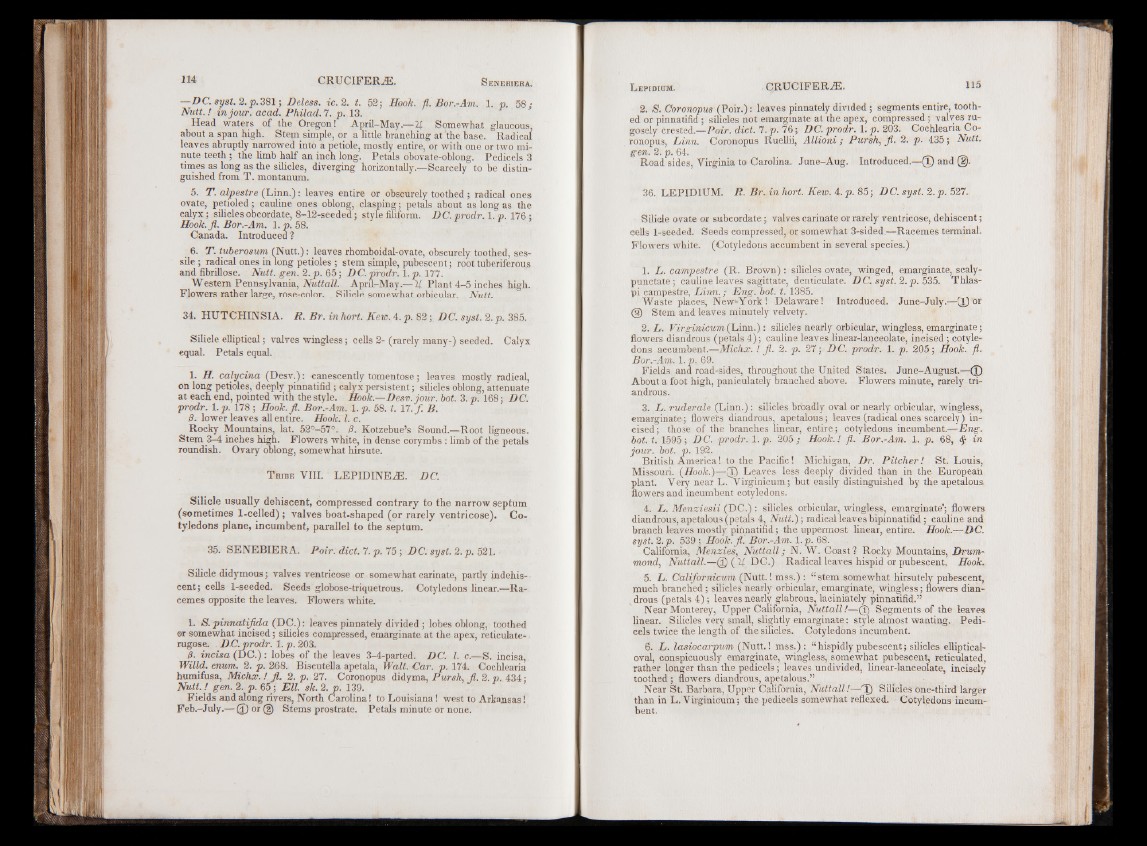
—DC.syst.2.p.381-} Deless. ic.2. t. 52; Hook. fl. Bor.-Am. 1. p. 58;
Nu tt.! in jour. acad. Philad. 7. p. 13.
Head waters of the Oregon! April-May.— Somewhat glaucous,
about a span high. Stem simple, or a little branching at ‘the base. Radical
leaves abruptly narrowed into a petiole, mostly entire, or with one or two minute
teeth; the limb half an inch long. Petals obovate-oblong. Pedicels 3
times as long as the silicles, diverging horizontally.—Scarcely to be distinguished
from T. montanum.
5. T. alpestre (Linn.): leaves entire or obscurely toothed; radical ones
ovate, petioled; cauline ones oblong, clasping; petals about as long as the
calyx; silicles obcordate, 8-12-seeded; style filiform. DC. prodr. 1. p. 176 ;
Hook.jl. Bor.-Am. 1. p. 58.
Canada. Introduced ?
6. T. tuberosum (Nutt.): leaves rhomboidal-ovate, obscurely toothed, sessile;
radical ones in long petioles ; stem simple, pubescent; root tuberiferous
and fibrillose. Nutt. gen. 2. p. 65; DC. prodr. 1. p. 177.
Western Pennsylvania, Nuttall. April-May.— If Plant 4-5 inches high.
Flowers rather large, rose-color. Silicle somewhat orbicular. Nutt.
34. HUT CHIN SI A. R. Br. inhort. Kew. 4. p. 82; DC. syst. 2. p. 385.
Silicle elliptical; valves wingless; cells 2- (rarely many-) seeded. Calyx
equal. Petals equal.
1. H. calycina (Desv.): canescently tomentose; leaves mostly radical,
on long petioles, deeply pinnatifid ; calyx persistent; silicles oblong, attenuate
at each end, pointed with the style. Hook.—Desv. jour. hot. 3. p. 168; DC.
prodr. 1. p. 178 ; Hook.jl. Bor.-Am. l.p . 58. t. 17. f . B.
13. lower leaves all entire. Hook. 1. c.
Rocky Mountains, lat. 52°-57°. /?. Kotzebue’s Sound.—Root ligneous.
Stem 3-4 inches high. Flowers white, in dense corymbs : limb of the petals
roundish. Ovary oblong, somewhat hirsute.
T ribe VIII. LEPIDINEiE. DC.
Silicle usually dehiscent, compressed contrary to the narrow septum
(sometimes 1-celled); valves boat-shaped (or rarely ventricose). Cotyledons
plane, incumbent, parallel to the septum.
35. SENEBIERA. Poir. diet. 7. p. 75; DC. syst. 2. p. 521.
Silicle didymous; valves ventricose or somewhat carinate, partly indehis-
cent; cells 1-seeded. Seeds globose-triquetrous. Cotyledons linear.—Racemes
opposite the leaves. Flowers white. 1
1. S. pinnatiflda (DC.) : leaves pinnately divided ; lobes oblong, toothed
or somewhat incised ; silicles compressed, emarginate at the apex, reticulate-
rugose. DC. prodr. 1. p. 203.
/S. incisa (DC.) : lobes of the leaves 3-4-parted. DC. 1. c.—S. incisa,
Willd. enum. 2. p. 268. Biscutélla apetala, Walt. Car. p. 174. Cochlearia
humifusa, Michx. ! Jl. 2. p. 27. Coronopus didyma, Pursh, fl. 2. p. 434 ;
Nutt. ! gen. 2. p. 65 ; Ell. sk. 2 .p . 139.
Fields and along rivers, North Carolina ! to Louisiana ! west to Arkansas !
Feb.-July.— (Î) or (5) Stems prostrate. Petals minute or none.
2. S. Coronopus (Poir.) : leaves pinnately divided ; segments entire, toothed
or pinnatifid ; silicles not emarginate at the apex, compressed ; valves ru-
gosely crested.—Poir. diet. 7. p. 76 ; DC. prodr. 1. p. 203. Cochlearia Coronopus,
Linn. Coronopus Ruellii, Allioni ; Pursh, Jl. 2. p. 435 ; Nutt,
gen. 2. p. 64. _ _
Road sides, Virginia to Carolina. June-Aug. Introduced.—© and (2).
36. LEPIDIUM. R. Br. in hort. Kew. 4. p. 85; DC. syst. 2. p. 527.
Silicle ovate or subeordate; valves carinate or rarely ventricose, dehiscent;
cells 1-seeded. Seeds compressed, or somewhat 3-sided.—Racemes terminal.
Flowers white. (Cotyledons accumbent in several species.)
1. L. campestre (R. Brown): silicles ovate, winged, emarginate, scaly-
punctate; cauline leaves sagittate, denticulate. DC. syst. 2. p. 535. Thlas-
pi eampestre, Linn, ƒ Eng. bot. t. 1385.
Waste places, New-York! Delaware! Introduced. June-July.—(X) or
(§) Stem and leaves minutely velvety.
2. L. Virginicum (Linn.) : silicles nearly orbicular, wingless, emarginate;
flowers diandrous (petals 4); cauline leaves linear-lanceolate, incised ; cotyledons
accumbent.—M ich x .! Jl. 2. p. 27; DC. prodr. 1. p. 205; Hook. fl.
Bor.-Am. 1. p._ 69.
Fields and road-sides, throughout the United States. June-August.—(p
About a foot high, paniculately branched above. Flowers minute, rarely tn-
androus.
3. L. ruder ale (Linn.) : silicles broadly oval or nearly orbicular, wingless,
emarginate; flowers diandrous, apetalous; leaves (radical ones scarcely) incised;
those of the branches linear, entire; cotyledons incumbent.—Eng.
bot. t. 1595; DC. prodr. l.p . 205; Hook.! fl. Bor.-Am. 1. p. 68, <$■ in
jour. bot. p. 192.
British America! to the Pacific! Michigan, Dr. Pitcher! St. Louis,
Missouri. (Hook.)—(3) Leaves less deeply divided than in the European
plant. Very near L. Virginicum; but easily distinguished by the apetalous
flowers and incumbent cotyledons.
4. L. Menziesii (D C .): silicles orbicular, wingless, emarginate"; flowers
diandrous, apetalous (petals 4, N u tt.); radical leaves bipinnatifid; cauline and
branch leaves mostly pinnatifid; the uppermost linear, entire. Hook.—DC.
syst. 2.p. 539 ; Hook.jl. Bor.-Am. l.p . 68.
California, Menzies, Nuttall; N. W. Coast? Rocky Mountains, Drummond,
Nuttall.—@ ( 1( DC.) Radical leaves hispid or pubescent. Hook.
5. L. Californicum (Nutt.! mss.) : “ stem somewhat hirsutely pubescent,
much branched ; silicles nearly orbicular, emarginate, wingless; flowers diandrous
(petals 4) ; leaves nearly glabrous, laciniately pinnatifid.”
Near Monterey, Upper California, Nuttall!—(l) Segments of the leaves
linear. Silicles very small, slightly emarginate: style almost wanting. Pedicels
twice the length of the silicles. Cotyledons incumbent.
6. L. lasiocarpum (Nutt.! mss.): “ hispidly pubescent; silicles elliptical-
oval, conspicuously emarginate, wingless, somewhat pubescent, reticulated,
rather longer than the pedicels; leaves undivided, linear-lanceolate, incisely
toothed ; flowers diandrous, apetalous.”
Near St. Barbara, Upper California, Nuttall!—T) Silicles one-third larger
than in L. Virginicum; the pedicels somewhat reflexed. Cotyledons incumbent.